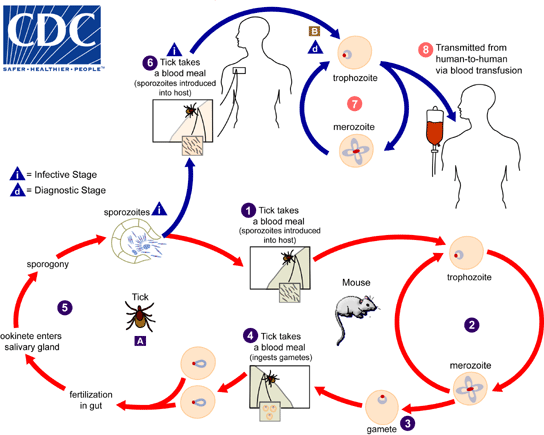Biology
Causal Agents:
Babesiosis is caused by apicomplexan parasites of the genus Babesia. Although more than 100 Babesia species have been reported, relatively few have caused documented cases of human infection; these include (but are not limited to) B. microti, B. divergens, B. duncani, and a currently unnamed agent designated MO1.
Life Cycle:

The Babesia microti life cycle involves two hosts, which include a rodent, primarily the white-footed mouse, Peromyscus leucopus, and a tick in the genus Ixodes. During a blood meal, a Babesia-infected tick introduces sporozoites into the mouse host ![]() . Sporozoites enter erythrocytes and undergo asexual reproduction (budding)
. Sporozoites enter erythrocytes and undergo asexual reproduction (budding) ![]() . In the blood, some parasites differentiate into male and female gametes, although these cannot be distinguished by light microscopy
. In the blood, some parasites differentiate into male and female gametes, although these cannot be distinguished by light microscopy ![]() . The definitive host is the tick. Once ingested by an appropriate tick
. The definitive host is the tick. Once ingested by an appropriate tick ![]() , gametes unite and undergo a sporogonic cycle resulting in sporozoites
, gametes unite and undergo a sporogonic cycle resulting in sporozoites ![]() . Transovarial transmission (also known as vertical, or hereditary, transmission) has been documented for "large" Babesia species but not for the "small" Babesia, such as B. microti
. Transovarial transmission (also known as vertical, or hereditary, transmission) has been documented for "large" Babesia species but not for the "small" Babesia, such as B. microti ![]() .
.
Humans enter the cycle when bitten by infected ticks. During a blood meal, a Babesia-infected tick introduces sporozoites into the human host ![]() . Sporozoites enter erythrocytes
. Sporozoites enter erythrocytes ![]() and undergo asexual replication (budding)
and undergo asexual replication (budding) ![]() . Multiplication of the blood-stage parasites is responsible for the clinical manifestations of the disease. Humans usually are dead-end hosts. However, human-to-human transmission is well recognized to occur via contaminated blood transfusions
. Multiplication of the blood-stage parasites is responsible for the clinical manifestations of the disease. Humans usually are dead-end hosts. However, human-to-human transmission is well recognized to occur via contaminated blood transfusions ![]() .
.
Life cycle image and information courtesy of DPDx.
- Page last reviewed: March 17, 2015
- Page last updated: March 17, 2015
- Content source:


 ShareCompartir
ShareCompartir